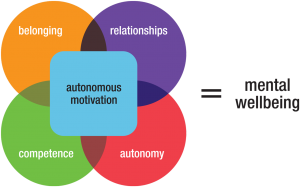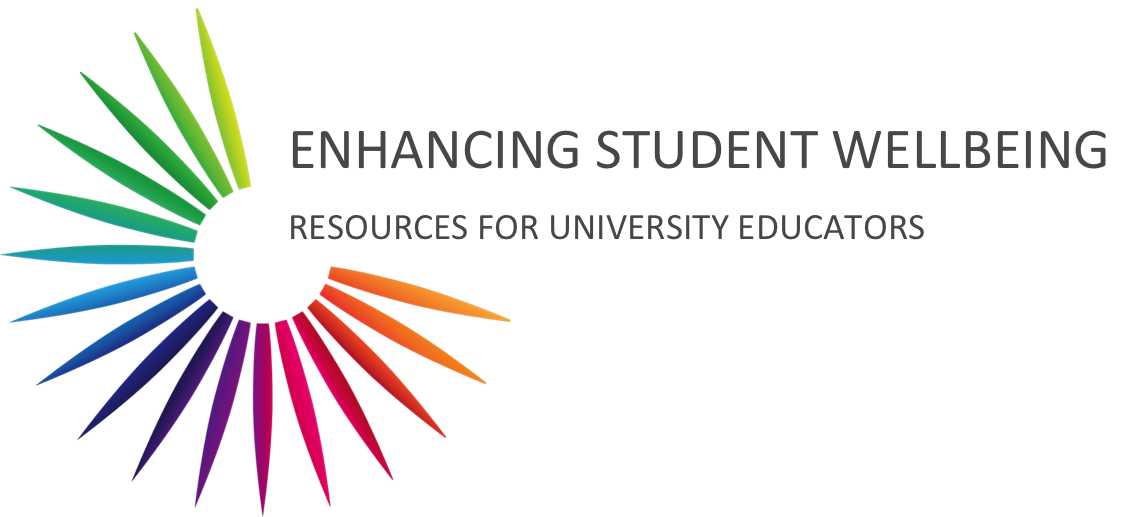Mental Wellbeing Essentials
The stressors inherent in a mass higher education system and an increasingly uncertain and challenging employment market cannot be eliminated, only mitigated and managed. To this end, all students can benefit from learning and teaching environments intentionally designed to support psychological wellbeing.
How can universities and academic educators support student mental wellbeing?
How? Empirical research consistently identifies that student mental wellbeing and academic achievement are both strengthened by learning environments that actively foster:
Wellbeing Essentials Explained
- Autonomous Motivation
- a sense of Belonging
- positive Relationships
- experiences of Autonomy
- feelings of Competence

Nurturing mental health
Self-Determination Theory (see READ MORE: SDT in brief, in the right-hand panel) posits that these fundamental psychological nutriments are available to and integrated by individuals when their actions are autonomously motivated (M), as illustrated in the figure above. This makes Autonomous Motivation a key driver of mental wellbeing, or the wellspring of psychological resources. The acronym M-BRAC is used in our learning modules to refer to these five mental health essentials (see READ MORE: M-BRAC explained, in the right-hand panel).
Autonomous Motivation: a key driver of mental wellbeing
- We enjoy the activities for their own sake; we find them intrinsically interesting or satisfying, or
- We believe the activities are important to achieving valued goals
When we are autonomously motivated to act, we have a sense of owning our actions and of our actions being ‘concordant’ with our interests and values. This is psychologically nurturing as it facilitates an integrated or coherent (authentic) sense of self.
Autonomous motivations are blunted and our wellbeing is undermined when we feel pressured to act or feel that we are being controlled by others. While external pressures can be energizing, acting in order to please or impress others, or to avoid disappointing them (controlled motivation), is not psychologically nurturing because it does not facilitate a sense of ‘being ourselves’ and acting in accordance with our true values and interests.
Autonomous motivation is also undermined when we feel that we are not capable of doing what we would like to do, or that our actions do not have any effect. Such beliefs can lead to ‘amotivation’ – or a lack of motivation to act intentionally and purposefully. This is another negative psychological state, as amotivated people simple ‘go through the motions’ without a sense of purpose or meaning.
Are university students autonomously motivated?
Intrinsic or extrinsic goals?
As with motivations, students’ academic goals are fluid, and influenced by the norms and values in the educational environment. Student mental wellbeing will be supported when teaching and learning practices actively connect –the knowledge and skills students are developing to intrinsic (rather than extrinsic) goals.
Research snapshot 1.3: Motivation and mental wellbeing in higher education
- In educational contexts, autonomous or positive motivation is associated with: increased effort and persistence, increased enjoyment and interest, proactive responses to mistakes and disappointments, and higher academic achievement (Ryan & Deci, 2000a; Vansteenkiste et al., 2006).
- Controlled motivations are associated with: resentment and compliance rather than interest and enthusiasm, strategic and instrumental (rather than mastery) learning approaches, defensive (rather than proactive) coping in response to mistakes and disappointments, and poorer academic performance (Ryan & Deci, 2000a; Vansteenkiste et al., 2006).
- Amotivation is associated with lack of self-regulation, application and effort (Ryan & Deci, 2000a).
- Both negatively motivated and amotivated students are at high risk for experiencing mental health difficulties (Larcombe & Fethers, 2013; Sheldon & Krieger, 2007).
- Autonomous motivation is sustained by and reliant on regular experiences of relatedness, autonomy, and competence (Deci & Ryan, 2000; Vansteenkiste et al., 2006).

